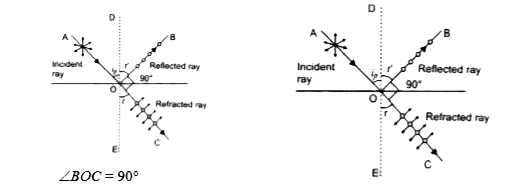(a) How does one demonstrate, using a suitable diagram, that unpolarised light when passed through a Polaroid gets polarised?
(b) A beam of unpolarised light is incident a glass-air interface. Show using a suitable ray diagram, that light reflected from the interface is totally polarised, when μ=taniB, when μ is the refractive index of glass with respect to air and iB, is the Brewster's angle.
Condition : The reflected ray is totally plane polarised, when reflected and refracted rays are perpendicular to each other.

If ip is angle of incidence, r' is angle of reflection and r the angle of refraction, then according to law of reflection
ip=r'
and form fig, r'+90∘+r=180∘
⇒ip+r=90∘...(i)
⇒r=(90∘−ip) ...(ii)
From Snell’s law, refractive index of second medium realstive to first medium (air) say.
n=sinipsinr=sinipsin(90∘−ip)=sinipcosip
⇒n=tanip
∴ Angle of incidence , ip=tan−1(n).
Topper's Solved these Questions
- CBSE Examination Paper Delhi–2014BOOK - CBSE COMPLEMENTARY MATERIALCHAPTER - CBSE Examination Paper Delhi–2014EXERCISE - Set-II (Questions Uncommon to Set-I)
10 Videos
- CBSE Examination Paper Delhi–2014BOOK - CBSE COMPLEMENTARY MATERIALCHAPTER - CBSE Examination Paper Delhi–2014EXERCISE - SET-III (Questions Uncommon to set-I and II)
9 Videos
- CBSE EXAMINATION PAPER - 2016 BOOK - CBSE COMPLEMENTARY MATERIALCHAPTER - CBSE EXAMINATION PAPER - 2016 EXERCISE - SECTION - E
17 Videos
- CBSE EXAMINATION PAPER, DELHI REGION - 2015 (CODE NO. 55/1/1/D)BOOK - CBSE COMPLEMENTARY MATERIALCHAPTER - CBSE EXAMINATION PAPER, DELHI REGION - 2015 (CODE NO. 55/1/1/D)EXERCISE - SECTION E
6 Videos
Similar Questions
(a) How does one demonstrate, using a suitable diagram, that unpolarised light when passed through a Polaroid gets polarised?
(b) A beam of unpolarised light is incident a glass-air interface. Show using a suitable ray diagram, that light reflected from the interface is totally polarised, when μ=taniB, when μ is the refractive index of glass with respect to air and iB, is the Brewster's angle.
View Solution(a) How does one demonstrate, using a suitable diagram, that unpolarised light when passed through a Polaroid gets polarised?
(b) A beam of unpolarised light is incident a glass-air interface. Show using a suitable ray diagram, that light reflected from the interface is totally polarised, when μ=taniB, when μ is the refractive index of glass with respect to air and iB, is the Brewster's angle.
View Solution
Knowledge Check
A ray of unpolarised light is incident on a glass plate of refractive index 1.54 at polarising angle, then angle of refraction is :
A33∘B44∘C57∘D90∘When unpolarised light beam is incident from air onto glass (n=1.5) at the polarising angle
A(a) Reflected beam is polarised 100 percentB(b) Reflected and refracted beams are partially polarisedC(c) The reason for (a) is that almost all the light is reflectedD(d) All of the aboveAssertion (A) : When an unpolarised light is incident on a glass plate at Brewster angle, the reflected ray and refracted ray mutually perpendicular
Reason (R ) : The refractive index of glass is equal to sine of the angle of polarisation.ABoth 'A' and 'R' are true and 'R' is the correct explanation of 'A'BBoth 'A' and 'R' are true and 'R' is not the correct explanation of 'A'CA' is true and 'R' is falseDA' is false and 'R' is true
A beam of unpolarized light is incident on a glass air interface. Show, using a suitable ray diagram that light reflected from the interface is totally polarized by reflection from a transparent medium. Write expression for Brewster's angle.
View SolutionUnpolarised light is incident on a plane surface of glass of glass of refractive index n at angle i. If the reflected light gets totally polarised, write the relation between the angle i and refractive index n.
View SolutionUnpolarized light is incident on a plane surface of glass of refractive index μ at angle i. If the reflected light gets totally polarized, write the relation between the angle i and refractive index μ.
View Solution(a) What is linearly polarised light ? Describe briefly using a diagram how sunlight is polarised
(b) Unpolarised light is incident on a polaroid. How would the intensity of transmitted light change when the polaroid is rotated ?
View SolutionThe angle of incidence at which reflected light is totally polarised for reflection from air to glass (refractive index n) is
View Solution
